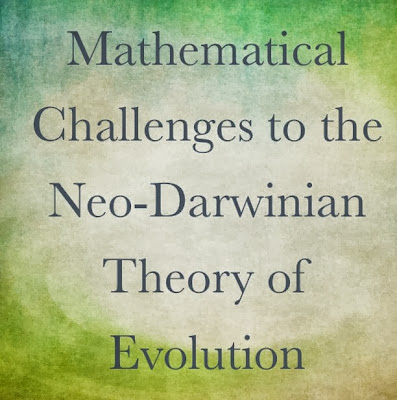This
material is excerpted from the book, History of Evolutionary Theory.
An
asterisk ( * ) by a name indicates that person is not known to be a
creationist.
The Philadelphia Meeting
At
Wistar Institute meeting in Philadelphia evolutionary theory was destroyed by
mathematical facts. "The ascription of all changes in form to chance has
long caused raised eyebrows. Let us not dally with the doubts of
nineteenth-century critics, however; for the issue subsided. But it raised its
ugly head again in a fairly dramatic form in 1967, when a handful of
mathematicians and biologists were chattering over a picnic lunch organized by
the physicist, Victor Weisskopf, who is a professor at Massachusetts Institute
of Technology (MIT) and one of the original Los Alamos atomic bomb group, at
his house in Geneva. A rather weird discussion took place. The subject was
evolution by natural selection. The mathematicians were stunned by the optimism
of the evolutionists about what could be achieved by chance. So wide was the
rift that they decided to organize a conference, which was called Mathematical
Challenges to the Neo-Darwinian Theory of Evolution.
The
conference was chaired by Sir Peter Medawar, whose work on graft rejection won
him a Noble prize and who, at the time, was director of the Medical Research
Council's laboratories in North London. Not, you will understand, the kind of
man to speak wildly or without careful thought. In opening the meeting, he
said: `The immediate cause of this conference is a pretty widespread sense of
dissatisfaction about what has come to be thought of as the accepted
evolutionary theory in the English-speaking world, the so-called neo-Darwinian
theory. This dissatisfaction has been expressed from several quarters."—*G.R.
Taylor, Great Evolution Mystery (1983), p. 4. A milestone meeting was the
Wistar Institute Symposium held in Philadelphia in April 1966. The chairman,
*Sir Peter Medawar, made the following opening remark:
“The
immediate cause of this conference is a pretty widespread sense of dissatisfaction
about what has come to be thought as the accepted evolutionary theory in the
English-speaking world, the so-called neo-Darwinian theory. These objections to
current neo-Darwinian theory are very widely held among biologists generally;
and we must, on no account I think, make light of them.
*Peter
Medawar, remarks by the chairman, “Paul Moorhead and *Martin Kaplan,
Mathematical Challenges to the Neo-Darwinian Interpretation of Evolution,
Wistar Institute Monograph No. 5
A
number of mathematicians, familiar with the biological problems, spoke at that
1966 Wistar Institute. They cleverly refuted neo-Darwinism in several areas,
and showed that its “fitness” and “adaptation” theories are tautologous –
little more than circular reasoning. In contrast, some of the biologists who
spoke at the convention could not see the light. They understood bugs and
turtles, but could not grasp neither the mathematical impossibilities of the
evolutionary theory nor the broad picture of how thoroughly defunct evolution
really is. For example, one of the mathematicians, *Murray Eden of MIT
explained that life could not begin by the “random selection”, which is the
basic pillar of evolutionary teaching. Yet he said that if randomness is set
aside, then only “design” would remain – and that would require purposive
planning by Intelligence.
*C.H.
Washington, a prominent British evolutionist, scathingly attacked
neo-Darwinism, maintaining that all it proved was that plants and animals could
have offspring.
The
1966 Wistar Convention was the result of a meeting of mathematicians and
biologists the year before in Switzerland. Mathematical doubts about Darwinian
theory ha been raised, and, at the end of several hours of heated discussion,
it was agreed that a meeting be held the next year to more fully air the
problems”. *Dr. Martin Kaplan then set to work to lay plans for the 1966 Wistar
Institute Convention.
It was
the development of tremendously powerful digital computers that sparked the controversy.
At last mathematicians were able to work out the probability of evolution ever
having occurred. They discovered that, mathematically, life would neither have
begun nor evolved by random action.
For four days the Wistar convention continued,
during which a key lecture was delivered by *M.P. Schutzenberger, a computer
scientist, who explained that computers are large enough now to totally work
out the mathematical probabilities of evolutionary theory—and they demonstrate
that it is really fiction.
*Murray Eden showed that it would be impossible
for even a single ordered pair of genes to be produced by DNA mutations in the
bacteria, E. coli,
—with 5 billion years in which to produce it! His estimate was based on 5
trillion tons of the bacteria covering the planet to a depth of nearly an inch
during those 5 billion years. He then explained that the genes of E. coli contain over a trillion (1012)
bits of data. That is the number 10 followed by 12 zeros. *Eden then showed the
mathematical impossibility of protein forming by chance. He also reported on
his extensive investigations into genetic data on hemoglobin (red blood cells).
Hemoglobin has two chains, called alpha and beta.
A minimum of 120 mutations would be required to convert alpha to beta. At least
34 of those changes require changeovers in 2 or 3 nucleotides. Yet, *Eden
pointed out that, if a single nucleotide change occurs through mutation, the
result ruins the blood and kills the organism!
*George Wald stood up and explained that he had
done extensive research on hemoglobin also, —and discovered that if just ONE
mutational change of any kind was made in it, the hemoglobin would not function
properly. For example, the change of one amino acid out of 287 in hemoglobin
causes sickle-cell anemia. A glutamic acid unit has been changed to a valine
unit—and, as a result, 25% of those suffering with this anemia die.
For
more information on the 1966 Wistar Institute, we refer you to the book quoted
above, by *Moorehead and *Kaplan.

No comments:
Post a Comment